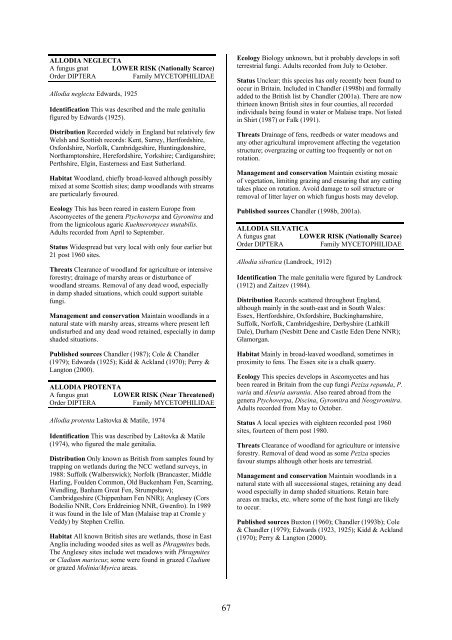Part 2: Nematocera and Aschiza not dealt with by Falk (1991) - JNCC
Part 2: Nematocera and Aschiza not dealt with by Falk (1991) - JNCC
Part 2: Nematocera and Aschiza not dealt with by Falk (1991) - JNCC
You also want an ePaper? Increase the reach of your titles
YUMPU automatically turns print PDFs into web optimized ePapers that Google loves.
ALLODIA NEGLECTA<br />
A fungus gnat LOWER RISK (Nationally Scarce)<br />
Order DIPTERA<br />
Family MYCETOPHILIDAE<br />
Allodia neglecta Edwards, 1925<br />
Identification This was described <strong>and</strong> the male genitalia<br />
figured <strong>by</strong> Edwards (1925).<br />
Distribution Recorded widely in Engl<strong>and</strong> but relatively few<br />
Welsh <strong>and</strong> Scottish records: Kent, Surrey, Hertfordshire,<br />
Oxfordshire, Norfolk, Cambridgeshire, Huntingdonshire,<br />
Northamptonshire, Herefordshire, Yorkshire; Cardiganshire;<br />
Perthshire, Elgin, Easterness <strong>and</strong> East Sutherl<strong>and</strong>.<br />
Habitat Woodl<strong>and</strong>, chiefly broad-leaved although possibly<br />
mixed at some Scottish sites; damp woodl<strong>and</strong>s <strong>with</strong> streams<br />
are particularly favoured.<br />
Ecology This has been reared in eastern Europe from<br />
Ascomycetes of the genera Ptychoverpa <strong>and</strong> Gyromitra <strong>and</strong><br />
from the lignicolous agaric Kuehneromyces mutabilis.<br />
Adults recorded from April to September.<br />
Status Widespread but very local <strong>with</strong> only four earlier but<br />
21 post 1960 sites.<br />
Threats Clearance of woodl<strong>and</strong> for agriculture or intensive<br />
forestry; drainage of marshy areas or disturbance of<br />
woodl<strong>and</strong> streams. Removal of any dead wood, especially<br />
in damp shaded situations, which could support suitable<br />
fungi.<br />
Management <strong>and</strong> conservation Maintain woodl<strong>and</strong>s in a<br />
natural state <strong>with</strong> marshy areas, streams where present left<br />
undisturbed <strong>and</strong> any dead wood retained, especially in damp<br />
shaded situations.<br />
Published sources Ch<strong>and</strong>ler (1987); Cole & Ch<strong>and</strong>ler<br />
(1979); Edwards (1925); Kidd & Ackl<strong>and</strong> (1970); Perry &<br />
Langton (2000).<br />
ALLODIA PROTENTA<br />
A fungus gnat LOWER RISK (Near Threatened)<br />
Order DIPTERA<br />
Family MYCETOPHILIDAE<br />
Allodia protenta Laštovka & Matile, 1974<br />
Identification This was described <strong>by</strong> Laštovka & Matile<br />
(1974), who figured the male genitalia.<br />
Distribution Only known as British from samples found <strong>by</strong><br />
trapping on wetl<strong>and</strong>s during the NCC wetl<strong>and</strong> surveys, in<br />
1988: Suffolk (Walberswick); Norfolk (Brancaster, Middle<br />
Harling, Foulden Common, Old Buckenham Fen, Scarning,<br />
Wendling, Banham Great Fen, Strumpshaw);<br />
Cambridgeshire (Chippenham Fen NNR); Anglesey (Cors<br />
Bodeilio NNR, Cors Erddreiniog NNR, Gwenfro). In 1989<br />
it was found in the Isle of Man (Malaise trap at Cromle y<br />
Veddy) <strong>by</strong> Stephen Crellin.<br />
Habitat All known British sites are wetl<strong>and</strong>s, those in East<br />
Anglia including wooded sites as well as Phragmites beds.<br />
The Anglesey sites include wet meadows <strong>with</strong> Phragmites<br />
or Cladium mariscus; some were found in grazed Cladium<br />
or grazed Molinia/Myrica areas.<br />
Ecology Biology unknown, but it probably develops in soft<br />
terrestrial fungi. Adults recorded from July to October.<br />
Status Unclear; this species has only recently been found to<br />
occur in Britain. Included in Ch<strong>and</strong>ler (1998b) <strong>and</strong> formally<br />
added to the British list <strong>by</strong> Ch<strong>and</strong>ler (2001a). There are now<br />
thirteen known British sites in four counties, all recorded<br />
individuals being found in water or Malaise traps. Not listed<br />
in Shirt (1987) or <strong>Falk</strong> (<strong>1991</strong>).<br />
Threats Drainage of fens, reedbeds or water meadows <strong>and</strong><br />
any other agricultural improvement affecting the vegetation<br />
structure; overgrazing or cutting too frequently or <strong>not</strong> on<br />
rotation.<br />
Management <strong>and</strong> conservation Maintain existing mosaic<br />
of vegetation, limiting grazing <strong>and</strong> ensuring that any cutting<br />
takes place on rotation. Avoid damage to soil structure or<br />
removal of litter layer on which fungus hosts may develop.<br />
Published sources Ch<strong>and</strong>ler (1998b, 2001a).<br />
ALLODIA SILVATICA<br />
A fungus gnat LOWER RISK (Nationally Scarce)<br />
Order DIPTERA<br />
Family MYCETOPHILIDAE<br />
Allodia silvatica (L<strong>and</strong>rock, 1912)<br />
Identification The male genitalia were figured <strong>by</strong> L<strong>and</strong>rock<br />
(1912) <strong>and</strong> Zaitzev (1984).<br />
Distribution Records scattered throughout Engl<strong>and</strong>,<br />
although mainly in the south-east <strong>and</strong> in South Wales:<br />
Essex, Hertfordshire, Oxfordshire, Buckinghamshire,<br />
Suffolk, Norfolk, Cambridgeshire, Der<strong>by</strong>shire (Lathkill<br />
Dale), Durham (Nesbitt Dene <strong>and</strong> Castle Eden Dene NNR);<br />
Glamorgan.<br />
Habitat Mainly in broad-leaved woodl<strong>and</strong>, sometimes in<br />
proximity to fens. The Essex site is a chalk quarry.<br />
Ecology This species develops in Ascomycetes <strong>and</strong> has<br />
been reared in Britain from the cup fungi Peziza rep<strong>and</strong>a, P.<br />
varia <strong>and</strong> Aleuria aurantia. Also reared abroad from the<br />
genera Ptychoverpa, Discina, Gyromitra <strong>and</strong> Neogyromitra.<br />
Adults recorded from May to October.<br />
Status A local species <strong>with</strong> eighteen recorded post 1960<br />
sites, fourteen of them post 1980.<br />
Threats Clearance of woodl<strong>and</strong> for agriculture or intensive<br />
forestry. Removal of dead wood as some Peziza species<br />
favour stumps although other hosts are terrestrial.<br />
Management <strong>and</strong> conservation Maintain woodl<strong>and</strong>s in a<br />
natural state <strong>with</strong> all successional stages, retaining any dead<br />
wood especially in damp shaded situations. Retain bare<br />
areas on tracks, etc. where some of the host fungi are likely<br />
to occur.<br />
Published sources Buxton (1960); Ch<strong>and</strong>ler (1993b); Cole<br />
& Ch<strong>and</strong>ler (1979); Edwards (1923, 1925); Kidd & Ackl<strong>and</strong><br />
(1970); Perry & Langton (2000).<br />
67
















